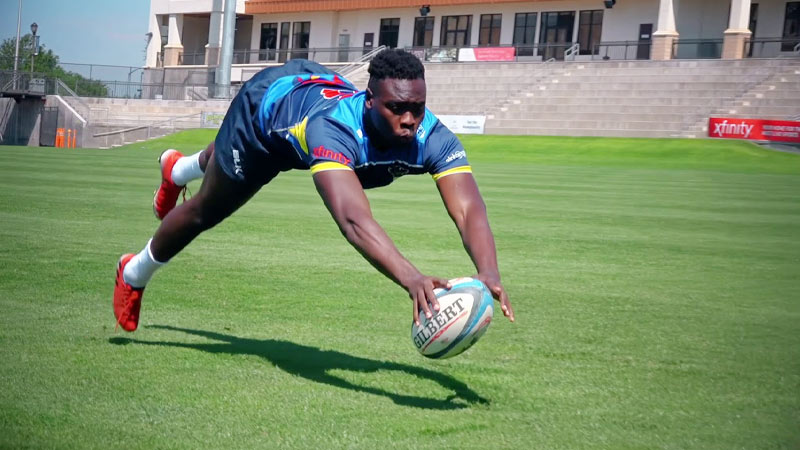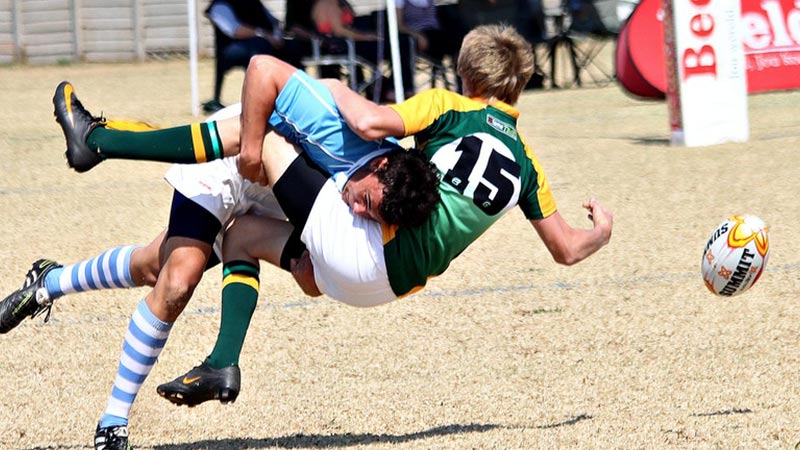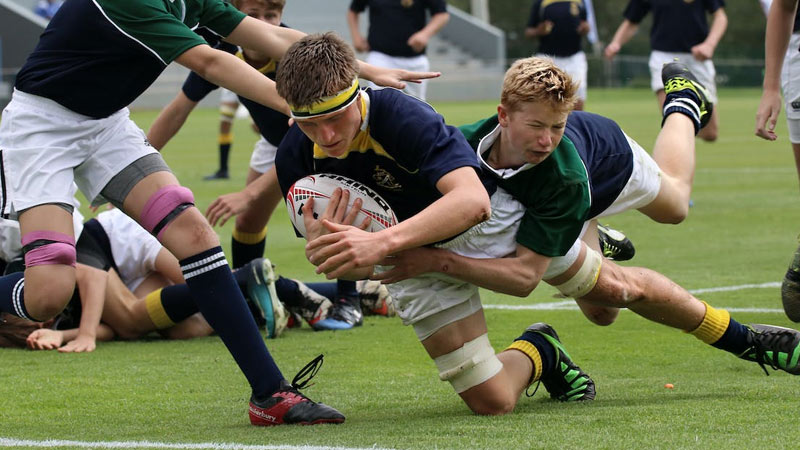In the dynamic world of sports, terminology often varies from one game to another, reflecting the unique rules and intricacies of each sport. When it comes to rugby, a sport celebrated for its rugged intensity and strategic gameplay, the concept of a “passing touchdown” is notably absent.
In rugby, players employ a distinct vocabulary of scoring methods, centered around tries, conversions, penalty kicks, drop goals, and penalty tries.
While rugby enthusiasts appreciate the intricacies of these scoring techniques, they understand that the term “passing touchdown” belongs to the realm of American football.
To delve into the thrilling world of rugby, it’s essential to grasp its unique scoring system and the excitement it brings to the field.
What Is a Passing Touchdown in Rugby?
In rugby, a passing touchdown is not a recognized term or concept. The term “touchdown” is more commonly associated with American football and is not used in rugby.
Rugby has its own unique terminology and scoring system. To avoid confusion, it’s essential to understand the differences between the two sports.
In rugby, the primary objective is to score points by carrying the ball over the opponent’s goal line or by kicking it through the goalposts.
Here’s how scoring works in rugby:
Try (5 points)
In rugby, scoring a try is the ultimate achievement. It involves a player carrying the ball across the opponent’s goal line and grounding it with downward pressure.
This demonstrates control over the ball and signifies a successful try, which is worth five points. Tries often result from a combination of teamwork, skillful ball-handling, and well-executed passes.
Conversion (2 points)
Following a try, the scoring team is granted a conversion attempt. This involves a kicker trying to send the ball through the opponent’s goalposts.
A successful conversion adds two points to the team’s score. It’s a crucial aspect of scoring in rugby, as it can turn a five-point try into a seven-point play.
Penalty Kick (3 points)
Penalty kicks are a way for a team to score when the opposition commits a foul or violates the rules.
When a foul occurs, the wronged team has the option to attempt a penalty kick at the goalposts from the spot where the infringement took place.
A successful penalty kick is worth three points and serves as a punishment for the opposing team’s wrongdoing.
Drop Goal (3 points)
A drop goal is a scoring method that can be attempted at any point during open play. To score a drop goal, a player must kick the ball over the opponent’s goalposts while the game is in motion.
Successfully executing a drop goal earns the team three points. This is often used strategically to break a tie or extend a lead.
Penalty Try (7 points)
The penalty try is a rare occurrence in rugby, typically awarded by the referee in specific situations. It comes into play when a team is likely to score a try but is prevented from doing so due to foul play by the opposing team.
Rather than the usual five points for a try, a penalty try is worth seven points, and no conversion attempt is required. It serves as a significant deterrent against foul play near the opponent’s goal line.
Scoring a Passing Touchdown

Scoring a passing touchdown is a fundamental aspect of American football, not rugby. In American football, a passing touchdown occurs when a quarterback throws the ball to a receiver, and the receiver successfully catches the ball in the opponent’s end zone, which is the area behind their goal line.
Here’s a breakdown of scoring a passing touchdown in American football:
Quarterback’s Throw
It starts with the quarterback, who is the team’s primary passer. The quarterback aims to throw the ball accurately to a receiver, tight end, or running back near or in the opponent’s end zone.
Receiver’s Catch
The receiver must catch the ball while keeping both feet in bounds within the end zone or possess the ball in a way that extends across the goal line.
A player who catches the ball with both feet in the end zone is immediately awarded a touchdown.
Touchdown Signal
When the officials determine that a player has scored a passing touchdown, they signal by extending both arms above their head with their palms facing each other. This indicates that the offensive team has earned six points.
Extra Point Attempt
After scoring a passing touchdown, the scoring team has the option to attempt an extra point. This is typically done by kicking the ball through the opponent’s goalposts, earning one additional point.
Alternatively, the team can attempt a two-point conversion, where they have one chance to score from a short distance.
Why Is a Touchdown in Rugby Called a Try?

The term “try” in rugby is used to describe the action of a player attempting to ground the ball behind the opponent’s goal line, and it has historical origins dating back to the early days of rugby football.
The term “try” in this context means an attempt to score, and it reflects the original scoring method in rugby.
When rugby was first codified in the 19th century, the game underwent several rule changes and evolved from its predecessor, various forms of football.
During this process, the scoring system was not as standardized as it is today. Instead of the modern point system, we see today, rugby initially used a different method to award points.
In the early days of rugby, there were no points awarded for simply crossing the goal line and touching the ball down, as in today’s try.
Instead, a player was allowed to try and “try” to kick the ball over the crossbar and between the goalposts to score. Hence, the term “try” came to represent the attempt to earn points in this manner. Over time, the scoring system evolved, and points were awarded differently.
The try as we know it today, where a player carries the ball over the goal line and grounds it to score five points, was introduced. However, the term “try” remained in use, likely due to tradition and historical continuity.
So, a “try” in rugby is essentially a remnant of the sport’s early scoring methods, and it has persisted as part of the game’s rich history and terminology.
Despite its historical origins, the term “try” is now widely recognized and understood by rugby players and fans around the world.
Significance of Passing Touchdowns in Rugby

In rugby, there is no concept of a “passing touchdown” as there is in American football. The two sports have distinct rules, terminology, and scoring systems.
However, let’s explore the importance of passing and ball movement in rugby, as well as the role of tries in the game:
Teamwork and Ball Movement
Passing is a fundamental aspect of rugby. Players often pass the ball laterally or backward to teammates as they work together to advance the ball up the field.
The ability to make accurate passes under pressure, combined with effective running lines, allows a team to create opportunities to score tries.
Setting Up Tries
Passing in rugby is crucial for setting up scoring opportunities, particularly tries. Teams use a combination of passing, running, and tactical play to breach the opponent’s defensive line and create space for a player to carry the ball over the try line and ground it for a try.
Creating Space
Passing can be used strategically to move the ball away from the opposition’s defensive players and into the hands of faster or more agile teammates. This creates space and opportunities to exploit gaps in the defense and potentially score tries.
Try Scoring
In rugby, the primary way to score points is by scoring a try. A try is worth five points and is the ultimate objective of attacking play.
Passing plays a critical role in the buildup to a try, as players work together to move the ball into a position where a teammate can cross the try line and ground the ball.
Conversion Attempts
After scoring a try, the scoring team has the opportunity to attempt a conversion. While not directly related to passing, the conversion is an essential part of scoring in rugby and adds two points to the team’s score. It rewards the team for successfully executing a try.
FAQS
Is a Passing Touchdown Ever Mentioned in Rugby?
No, the term “passing touchdown” is not used in rugby. Rugby has its own distinct scoring terminology, and a passing touchdown, as seen in American football, is not part of the sport’s lexicon.
What Is the Primary Scoring Method in Rugby?
The primary scoring method in rugby is called a “try.” It involves a player carrying the ball over the opponent’s goal line and grounding it for five points. Passing is often integral to setting up a try.
Do Passing Plays Lead to Tries in Rugby?
Yes, passing plays are commonly used to create try-scoring opportunities in rugby. Players pass the ball laterally or backward to teammates as they work together to advance the ball and breach the opponent’s defense.
What Happens After Scoring a Try in Rugby?
After scoring a try in rugby, the scoring team has the opportunity to attempt a conversion kick. If successful, the conversion adds two points to their score.
Are There Any Terms in Rugby Similar to a Passing Touchdown?
While rugby does not use the term “passing touchdown,” it has its own unique terms related to scoring, such as a “drop goal” and a “penalty try.” These terms describe different methods of scoring points in rugby.
Conclusion
A passing touchdown in rugby is a thrilling and pivotal moment in the game, showcasing the essence of teamwork, skill, and precision. It represents the culmination of strategic ball movement and the collective effort of players on the field.
Unlike its American football counterpart, rugby’s passing touchdown requires players to work together to advance the ball across the try line, making it a true testament to collaboration and sportsmanship.
Scoring a passing touchdown not only adds valuable points to a team’s tally but also ignites the passion and enthusiasm of both players and fans alike. So, the next time you watch a rugby match, keep an eye out for these spectacular moments that epitomize the beauty of the sport.







